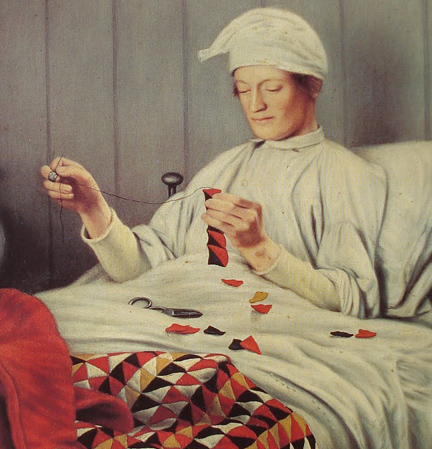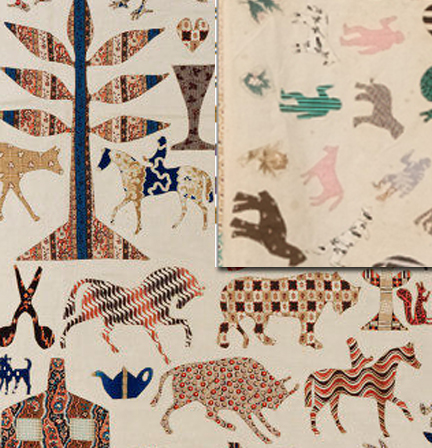Last week I wondered about the story on this unquilted bedcover in the collection of the Shelburne Museum. For sixty years it has been published as having been made by a recovering American soldier, a veteran of the Civil War.
Here is a corner block from the appliqued border.
The Shelburne's counterpane features a center panel with human figures, hearts and leafy vegetation floating on a white background, much like this bedcover:
Detail of the center of a British bedcover by Nancy Horsfall, 1833,
in the Gawthorpe Textiles Collection:
And this one where human figures, horses and other creatures float around a central star: the center of an 1874 bedcover by British children in the Cam Blue Coat School in the collection of Britain's Quilt Museum and Gallery.
The Shelburne coverlet's figures are similar to the horseman in this unquilted British bedcover in the collection of the Victoria and Albert Museum, which has prominent shapes based on on
Hiram Powers's 'The Greek Slave' sculpture done in 1846 (the figure in orange and red above.)
See the quilt at their website here:
Some shapes are similar in the Greek Slave bedcover and the Shelburne's but also important is another style characteristic popular with British patchworkers: the idea of cutting the applique from a large print. In the Greek Slave bedcover the maker was fond of buff and blue stripes:
Buff and blue stripes shaded in rainbow or fondu style were quite popular in America and England about 1840-1865, shown off to nice effect in this American block quilt from Laura Fisher Quilts.
The unknown maker of the Shelburne's counterpane also used large-scale buff and blue prints for figures.
I haven't seen the Shelburne's quilt in the cloth, so I don't really have any visual evidence that the fabrics are earlier than the 1870's period alluded to in the idea that a recovering American veteran made the quilt. I'm going more on style. The style incorporating an appliqued center in a field of triangular patchwork was done in both America and Britain, but by the 1870s Americans were no longer interested in a framed center design.
American Anna Tuel's quilt dated 1786,
a field of patchwork frames a central appliqued design.
Collection: Wadsworth Atheneum
Americans stopped using medallion sets with fields of patchwork early in the 19th century.
British frame quilt
Britons continued to favor the set into the 20th century.
Could the Shelburne's quilt be British?
And consider the social context: The idea of an American veteran doing patchwork for post-traumatic stress therapy is not a common story.
But it is a common story in Great Britain, where Crimean War soldiers were encouraged to stitch patchwork. A good body of surviving quilts offers evidence that they took to the activity enthusiastically.
Crimean War quilt
Sold at Kerry Taylor Auctions in London
The Battle of Balaclava, 1854
The Crimean War between Russia and England that took place in 1853-1856 is best remembered in the U.S. for Florence Nightingale's work with wounded soldiers, an inspiration to women in our Civil War (1861-1865).
Detail of Private Thomas Walker
by Thomas Wood, 1855
Collection: Royal College of Surgeons
The idea of men piecing scraps of wool into elaborate bedcovers was popular enough in Britain that an 1855 painting records the activity.
Americans did not follow the British practice of occupational therapy for recovering soldiers, however.
It is possible that the Shelburne's quilt was handed down with the story of a recovering soldier's making it---but recovering from a different war. This is all speculation but consider this image.
The Charge of the Light Brigade
by Richard Caton Woodville
We've all heard of the Light Brigade made famous in 1854. The Light Brigade were Lancers, horsemen who did not carry guns but fought with swords and lances---long sharp sticks---lighter than firearms.
The horsemen in the Shelburne's quilt
carry their arms more like lances than like guns.
I have one more post on this.
You have to wait till next week.












































